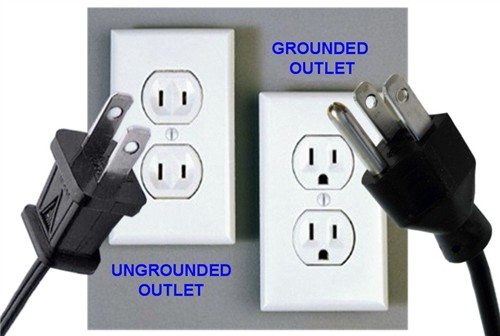

Make a loop at the end of the copper wire with a pair of needle-nose pliers. If the grounding wire has become loose or disconnected, loop the grounding wire over the green terminal screw and tighten with a Philips or flathead screwdriver. Simply moving it may have permanently damaged the insulation, making it unsafe to energize.Īttach the grounding wire to the grounding terminal. If you find very old wiring (black cloth around rubber-coated wiring), you may have to leave it alone and call an electrician to replace it properly.

Metal conduit and many types of metal-sheathed cables also serve as proper grounding means, provided they have an unbroken "path" bonded to a proper grounding point.If the metal outlet box has little to no resistance, then it’s grounded. If you have one of those, you can hook it up to a grounded receptacle and use an ohmmeter to check for resistance. If you have a ground wire, usually a bare copper or green wire, in a cable or conduit arriving in the box, it may or may not be grounded, which means you should test that for ground.
Grounded outlet code#

Grounded outlet upgrade#
If your home was wired "to code" initially, there is generally no legal requirement to upgrade to grounded outlets or GFCI (or even AFCI) outlets unless other work is being done that exposes the wiring.There are acceptable installation procedures for a non-grounded GFCI, usually involving putting a sticker on the receptacle cover stating "No Equipment Ground." The GFCI does not, itself, require any ground connection for proper operation. Check your local wiring codes to see if a three-prong GFCI is an acceptable replacement for a non-grounded two-prong receptacle.In some areas, you may need a GFCI due to nearby water fixtures. Outdoor GFCIs must also be weather resistant and clearly marked with the letters "WR," even if it has a weather cover. The National Electrical Code requires all GFCIs within 5 feet (1.5 m) of the floor to be tamper-resistant and clearly marked.Depending on where you live, you may be able to do the inspection yourself if you live in a single-family home.This needs to be done whether you're doing it yourself or hiring an electrician. X Research source To make sure you're up to code, you may need to schedule a temporary service inspection, a rough-in inspection, and a final inspection. Several inspections and permits are required for most residential construction projects, especially when it involves electrical work. Check your local electrical codes and schedule inspections.


 0 kommentar(er)
0 kommentar(er)
